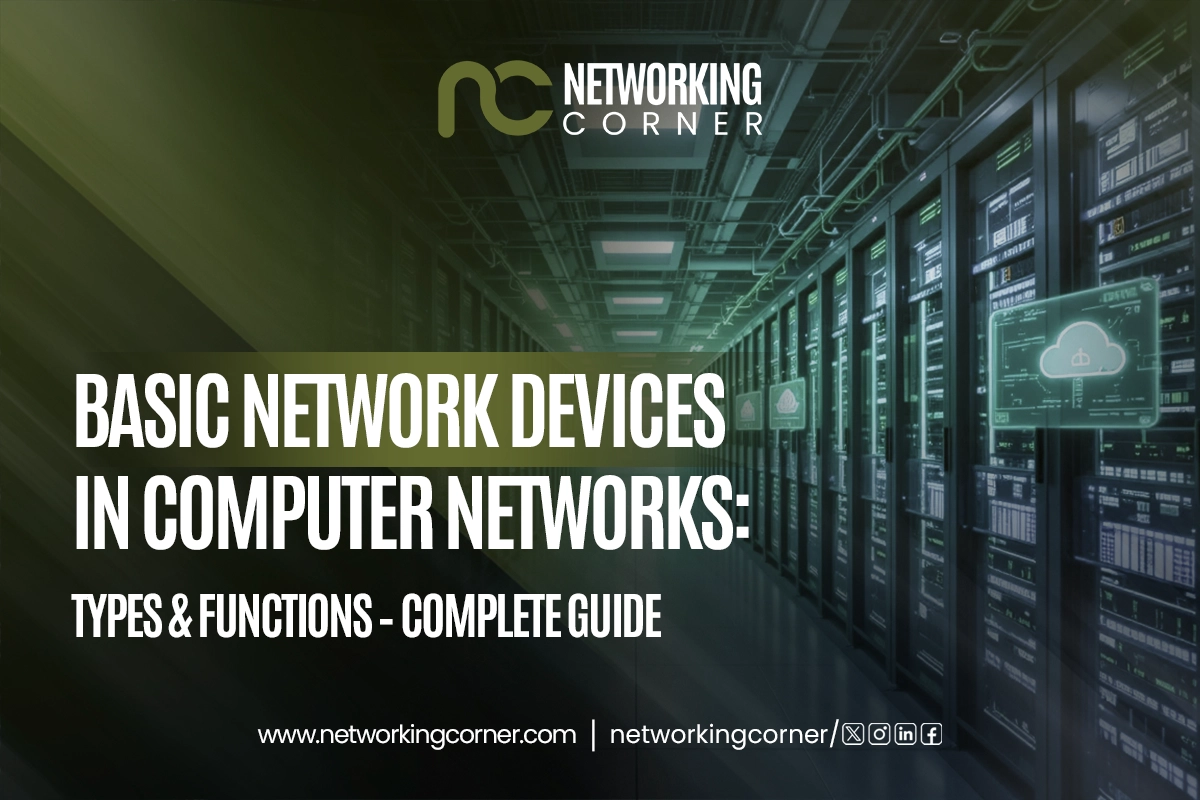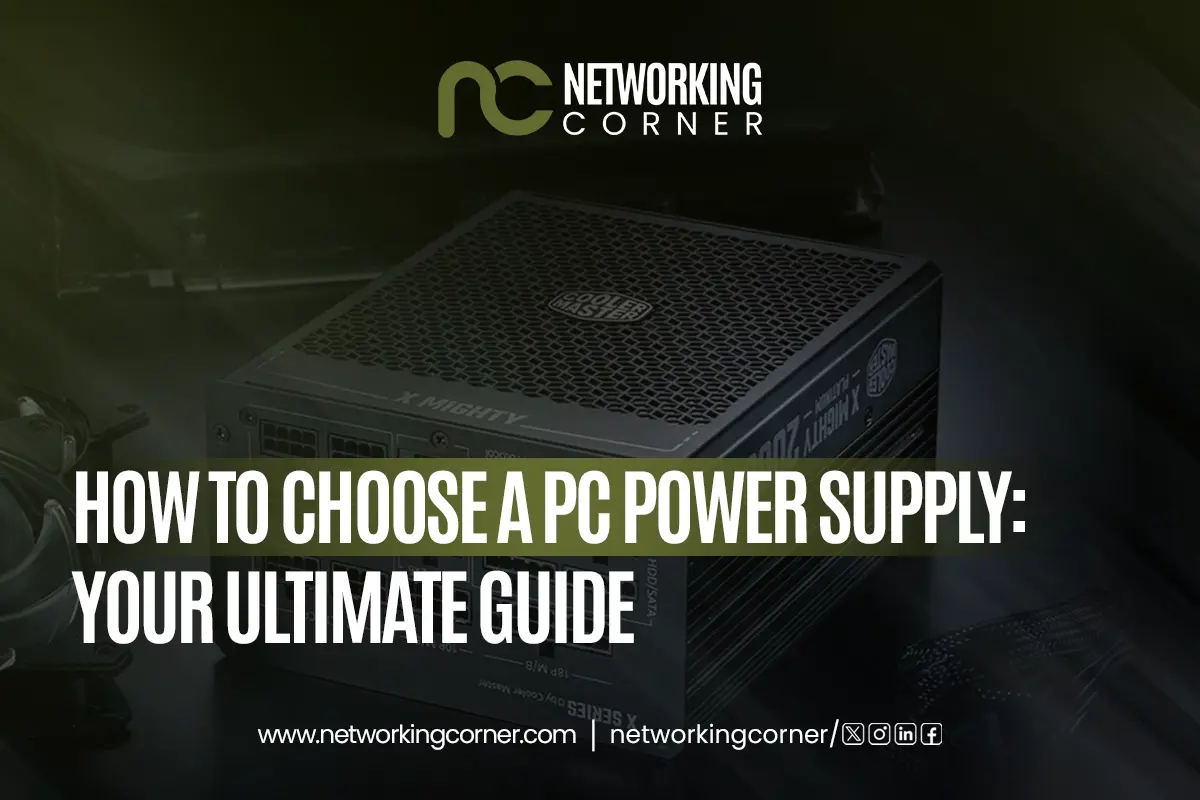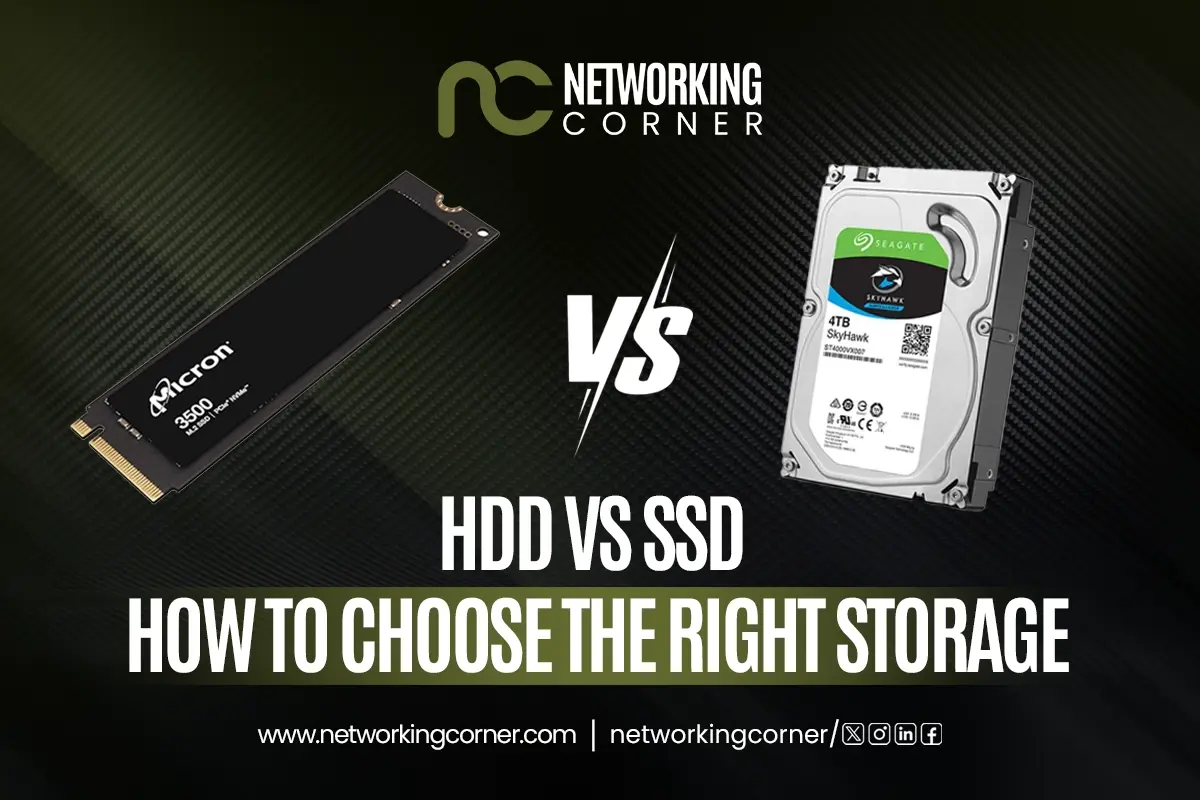
Modern life now revolves around computer networks as they allow gadgets to link to the internet, interact, and distribute resources. Any network is fundamentally composed of specialised equipment often referred to as network devices or network hardware devices. These devices are very vital in joining networks, traffic management, data transmission, security and performance maintenance.
For IT experts, network engineers, or even regular users looking to maximise network operations and security, knowledge of these computer network equipment parts and their particular purposes is vital.
Key network devices, their kinds, purposes, and reasons for importance in maintaining strong, effective and safe networks are fully covered in this guide.
What Are Network Devices?
From PCs, servers and smartphones to printers and IoT (Internet of Things) devices, these gadgets are in charge of sending, guiding, safeguarding and controlling data flow across many endpoints over local and worldwide networks.
Fundamentally, networking devices offer the structure that lets data flow naturally between people and systems. They create and preserve network connections so that data gets to its intended location fast, safely and consistently. Network devices provide interoperability across many hardware and software platforms by managing fundamental chores such as packet forwarding, traffic management, security enforcement and protocol translating.
At successive levels of the Open Systems Interconnection (OSI) paradigm, different kinds of network devices serve different purposes. Like switches and routers, some mainly manage data distribution and traffic. Others, including firewalls and Intrusion Detection & Prevention Systems (IDS/IDPS), concentrate on protecting the network from illegal access and cyber threats. Devices spanning modems, gateways and wireless access points reduce communication gaps across many network technologies or increase network availability to wireless users.
Furthermore, more important to contemporary, scalable network designs are virtual network devices, software-defined networking (SDN) components and cloud-based security appliances.
The importance of network devices lies in their ability to:
- Facilitate seamless communication: Supporting both local area networks (LANs) and wide area networks (WANs), they let devices within a network connect internally and outside.
- Manage data traffic efficiently: Even under severe loads, network devices provide seamless network performance by means of sophisticated data routing, switching and prioritising, therefore avoiding congestion.
- Secure sensitive information: Features including encryption, firewalls and intrusion detection help networks defend against data breaches, illegal access, and cyberattacks.
- Support scalability and flexibility: Modern networking tools allow networks to grow and change to fit increasing user, device, and application count.
Without these critical networking devices, contemporary computer networks would not be able to deliver the reliable connectivity, security, and performance demanded by today’s digital economy. From enterprise data centers and campus networks to home offices and mobile devices, network hardware serves as the backbone of global communications, powering everything from everyday internet browsing to complex enterprise operations and cloud computing infrastructures.
In simple terms, network devices enable computers, smartphones, servers, and other digital systems to connect with one another, communicate effectively, manage data traffic intelligently, and securely access both private networks and the broader internet.
Types of Network Devices and Their Functions
Let us now explore the most fundamental types of network hardware devices and their specific roles in computer networks. These devices collectively enable data transmission, maintain network security, manage traffic, and ensure smooth connectivity across both local and wide-area networks.
Routers
Among the most important parts of contemporary computer networks are routers. Their main role is to intelligibly guide network traffic between many separate networks and link them. Routers find the most effective way for data to reach its destination by examining arriving data packets, therefore guaranteeing dependable and timely communication.
Functions:
- Connect different networks (e.g., home network to the internet)
- Assign IP addresses through DHCP
- Enable communication between devices in different networks
- Offer built-in firewall features for basic security
Switches
Within Local Area Networks (LANs), switches are very vital components. Mainly operating at Layer 2, the Data Link Layer of the OSI model, switches control data flow between devices on the same network by guiding packets to their designated Media Access Control (MAC) address.
Functions:
- Forward data to the correct device based on MAC addresses
- Improve network efficiency and security
- Reduce congestion and slow network performance
Hubs
A hub is a simple and now largely obsolete networking device that operates at the Physical Layer (Layer 1). It connects multiple Ethernet devices and broadcasts incoming data to all connected ports indiscriminately, regardless of the intended recipient.
Functions:
- Connect multiple Ethernet devices together
- Broadcast incoming data to all ports
Bridges
Bridges function to connect two or more network segments, often dividing large networks into smaller, manageable units. By filtering traffic based on MAC addresses, bridges enhance the performance and security of interconnected networks.
Functions:
- Segment large networks into smaller, manageable parts
- Improve network performance and security
- Reduce collisions and traffic congestion
Repeaters
Repeaters play a critical role in extending the geographical range of networks. They amplify and regenerate weakened network signals to overcome degradation (attenuation) that naturally occurs over long distances.
Functions:
- Strengthen weak signals over long distances
- Extend network coverage without significant loss of data
Gateways
Gateways act as protocol converters, connecting networks that utilize different communication protocols or architectures. They operate across multiple OSI layers, providing interoperability between heterogeneous networks.
Functions:
- Connect networks using different communication protocols
- Translate data formats between incompatible networks
Brouters
Brouters combine the functionalities of bridges and routers, offering a hybrid solution that is effective in multi-protocol network environments.
Functions:
- Route data for known protocols
- Bridge data for unknown protocols
- Enhance traffic management and segmentation
Network Interface Card (NIC)
Whether cabled or wireless, a basic component allowing a device to physically connect and interact with a network is the Network Interface Card (NIC).
Functions:
- Provide hardware interface between the device and the network
- Enable wired or wireless communication
Modems
A modem, also known as a modulator-demodulator, helps enable internet access by turning digital impulses from computers into analogue signals that can be sent over telephone or cable lines and vice versa.
Functions:
- Modulate outgoing digital signals to analog
- Demodulate incoming analog signals to digital
- Provide access to the internet through ISPs
Network Cables
In computer networks, network cables transport data signals between devices and form the physical transmission media.
Types:
- Ethernet cables (Cat5e, Cat6, Cat6a)
- Fiber optic cables (for high-speed data over long distances)
Functions:
- Provide reliable wired connections
- Offer high bandwidth and low latency
Firewalls
Essential security tools called firewalls regulate data flow between trusted inside networks and untrusted outside networks, such as the Internet. Based on set security guidelines, they sort traffic.
Functions:
- Block unauthorized access
- Monitor network traffic for threats
- Separate trusted internal networks from untrusted external networks
Wireless Access Points (WAPs)
Wireless Access Points (WAPs) allow wireless devices to connect to the internet, hence spreading Wi-Fi throughout campuses or buildings.
Functions:
- Provide Wi-Fi access to smartphones, laptops, and tablets
- Extend wireless coverage in large areas
Intrusion Detection & Prevention Systems (IDPS)
Intrusion detection and prevention systems (IDPS) are advanced security solutions that monitor, identify, and react to hostile or illegal network activity.
Functions:
- Detect network attacks and anomalies
- Automatically block or mitigate security threats
- Log and report security incidents
Virtual Private Network (VPN) Appliances
VPN gadgets secure data transfers over public networks, including the internet, therefore allowing safe remote access to private networks.
Functions:
- Enable secure remote access
- Encrypt traffic to protect sensitive data
- Bypass geo-restrictions and censorship
Importance of Using the Right Computer Network Equipment
Building and sustaining scalable, safe, and efficient networks depends on choosing suitable computer networking equipment. The choice of networking equipment significantly affects network performance, security, and future expansion possibilities in a residential, business, or corporate setting.
1. Performance Enhancement
Using the right network equipment greatly increases data flow, helps to lower congestion, and lessens poor network performance. Devices that guarantee data packets reach their intended locations effectively help to optimise traffic management by switches, routers, and repeaters. Appropriate equipment choice guarantees that networks can manage growing workloads and preserve high-speed connections free from congestion.
2. Enhanced Security
Safeguarding private data depends on using security-minded technologies such as firewalls, Intrusion Detection and Prevention Systems (IDPS), and Virtual Private Network (VPN) appliances. Monitoring, filtering, and encrypting network traffic, these devices stop illegal access and guard against cyberattacks. Strong network security systems guarantee data integrity, confidentiality, and availability as well as reduce vulnerabilities.
3. Scalability and Flexibility
Choosing scalable and flexible networking gear lets networks expand naturally as personal or organisational demands change. Modular switches, expandable routers, and extra wireless access points allow simple network growth without completely redoing current infrastructure. Long-term cost-effectiveness and flexibility to evolving technological needs depend on this scalability.
Challenges in Network Device Monitoring and Management
Although implementing the appropriate network hardware devices has great benefits, properly administering and supervising these devices brings some natural difficulties. Ensuring best performance, security, and dependability is more difficult as networks get bigger and more complicated.
1. Complexity of Multi-Vendor and Multi-Protocol Environments
Operating under multiple protocols and standards, modern networks often consist of a mix of devices from different suppliers. Managing routers, switches, firewalls, wireless access points, security appliances each with unique settings and administrative interfaces may be intimidating. The integration of ancient systems with more modern technology increases the complexity even further, so centralised administration and interoperability become very difficult for network managers.
2. Security Risks from Misconfiguration and Oversight
Unconfigured devices provide major weaknesses in a network's architecture. Inappropriately protected wireless access points, unpatched firmware on routers, or poorly configured firewalls might provide malicious actors easy access. Crucially important but resource-intensive chores include maintaining uniform security rules across all devices, guaranteeing timely upgrades, and doing regular audits. Even most advanced security systems may fail to sufficiently protect data without careful administration.
3. Difficulties in Performance Monitoring and Issue Diagnosis
Without sophisticated network monitoring tools, keeping an eye on many linked devices is difficult. Whether sluggish network performance results from hardware failure, bandwidth overload, or configuration mistakes, determining the underlying problem may take time and be technically difficult. Network managers run the risk of ongoing downtime, lower productivity, and poor user experiences without complete awareness of device condition and traffic trends.
Conclusion
All contemporary computer systems are built upon network devices. Every gadget from routers, switches and firewalls to modems, VPN appliances and wireless access points helps to link networks, control traffic and protect data.
Selecting and maintaining appropriate networking tools guarantees best performance, lowers downtime and maintains data security. Maintaining awareness of the difficulties in network device monitoring is just as crucial if one wants consistent and effective operations.
Knowing the different kinds and purposes of every gadget will help you to create, grow, or fix your network architecture boldly and successfully.
FAQs
What are the main types of networking devices?
Routers, switches, hubs, bridges, repeaters and gateways define the primary forms of networking equipment. These tools control data flow, link many networks, and guarantee seamless computer network connectivity.
What are the uses of network switches?
By guiding data only to the device it is intended for, network switches control traffic within a local area network (LAN). This raises general efficiency and helps to ease network congestion.
How do wireless access points work?
To let devices connect without physical wires, a wireless access point (WAP) transmits a wireless signal from a wired network. Usually using Wi-Fi standards for communication, it serves as a link between the wired and wireless networks.
Can networking devices impact internet speed?
Yes, internet speed may be affected by routers, switches, and modems, among other networking equipment. Outdated or poorly configured devices may reduce data flow rates, create delays, or generate network congestion, therefore affecting general performance.
How do I secure my network devices?
Change default passwords, turn on firewalls, routinely update device firmware, and use encryption techniques to protect network devices. To guard against outside threats and unwanted access, think about using VPN equipment and IDPS.
What device allows you to connect two computers together in your network?
A switch or a hub will help you to link two PCs. A hub broadcasts to all connected devices; a switch is recommended for its efficiency in directing traffic only to the desired device.





